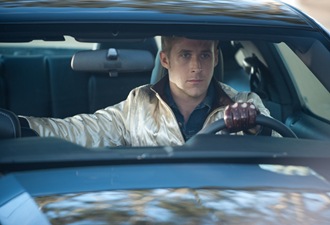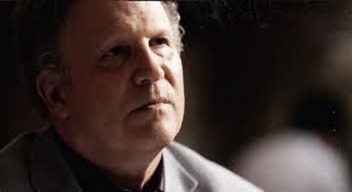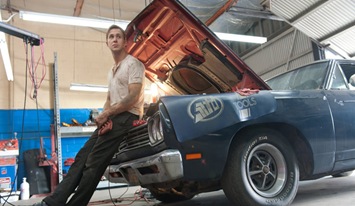2011
Director Nicolas Winding Refn
As the dramatic conclusion of this epic tale draws near, a man and woman enter an elevator, exchanging polite nods with their fellow rider. Within mere moments, said couple have engaged in a public kiss so passionate it would make even the most base Big Brother housemate blush, and the other rider is left prone, his skull a bloody, broken stew of scattered membrane. Welcome to Nicolas Winding Refn’s Drive, a film with all of the pulsating ultra-violence of Saw, the brooding existentialism of A History of Violence, and the sweet-natured centre of Lost In Translation. The combination of these cinematic pools is polarizing to say the least, and it sounds almost impossible to execute; but Refn, writer Hossein Amini and their superlative crew have not only succeeded in adapting James Sallis’ 2004 novel, but have produced one of the most enthralling, engaging and downright entertaining films of recent years.
And what a story to do it with.
At the heart of Drive is the aptly titled ‘Driver’, a loner who spends his days putting pedal to the metal, risking life and limb so that beautiful Hollywood stars don’t have to, or sticking his head inside a car’s bonnet at a dirty garage. But at night - for the right price of course - Driver will give you five minutes of his time - and only five minutes - to provide a means of escape for LA’s numerous criminals. Things become complicated for our anonymous hero, however, after he encounters Irene and her son Benicio. After falling - in completely different ways, it must be stressed - for the vulnerable pair; he even begins to help their returning jailbird of a husband and father, the troubled Standard. Driver’s protective nature leads him into conflict with local crime bosses Bernie Rose and Nino, two men with nothing but bad intentions when it comes to out enigmatic hero’s new adopted family.
Okay, so it sounds a bit like Shane. Okay, it sounds a LOT like Shane. But all that means is that Drive uses the same classic, Arthurian narrative that so many films and works of fiction have experimented with before. It’s thematically classic because it works. And works well. Extremely well. If the execution is there, what does it matter if the plot isn’t the most original piece of work ever? It does enough, and the execution is absolutely flawless. Refn has created the slickest, coolest flick of the year by a considerable distance. From the opening, pulse-jarring minutes, as we are shown what a true getaway is, to the perfectly shot, brilliantly framed, silhouetted final showdown with crime boss Bernie Rose, Refn and cinematographer Newton Thomas Sigel have created a Los Angeles so glossy that Michael Mann himself would nod in approval. It is nothing if not an enormous compliment to be compared to the work of Mann. Memories of the great director’s work are evoked throughout the course of Drive, from the dusty, blinding daytime of Heat and Public Enemies, to the sleek, noirish nights of Ali, Manhunter and, most obvious of all, Collateral. But this isn’t to say that Refn’s film is nothing but a collection of previous works. The fact that it visually resembles arguably the work of the finest ‘visual-realism’ director there has ever been is merely a testament to just how well Drive has been captured. Of course there are similarities with other films. The bleak nihilistic tone from Martin Scorsese’s Taxi Driver, featuring a man on the loose edge of sanity, dicing with heroism, and developing an enlightening, protective relationship with a vulnerable other. As strange as it might sound, American Psycho’s Patrick Bateman is the character most similar to Driver. Quiet, polite, but effortlessly cool, with a sudden change in expression that will inject fear into the heart of even the bravest soul.
It is here that we move onto the cast. Ryan Gosling - who seems to be going for a world record amount of films this year - is Driver. And he’s a revelation. Gosling has always been drifting closer and closer to the edgier side of cinema, from his Oscar nominated performance as a drug-tortured schoolteacher in Half Nelson to his visceral portrayal of a bitter, violent lover in Blue Valentine. He has what should be affectionately known as the ‘Christian Bale Look’. He’s a handsome man no doubt, but there is just something totally unsettling about that coy little smile. The way he can only lift the corners of his mouth. The way he looks at you. Alan Ladd never looked this dangerous in Shane. He is the full, fleshed-out version of what Tom Cruise’s Vincent from Collateral merely suggested. It simply doesn’t seem that unrealistic when he’s driving a shower pole through a man’s throat. In saying that, the scenes featuring Driver amidst the unfamiliar domesticity of Irene and her family are just as engaging as his scarlet-soaked head-stompings. Carey Mulligan doesn’t have a lot to do as the object of this psychopath’s affection other than look appealing, but it’s the warmth created by her, Kaden Leos’ Benicio, and Oscar Isaac as the incredibly likeable Standard that really create Drive’s emotional core. Because Driver alone is an empty vessel. The scenes of him in action are blisteringly cool, but it is this family unit that adds the extra layer to an already superb tale.
And the villains. Ah, the villains. Often the downfall of many a piece. With such an incredible character performance as Gosling’s, it is not unimaginable that the nasty old antagonists might be forgotten and left as an afterthought, becoming nothing but two dimensional caricatures of crime cliché. But this simply isn’t the case. First of all, we have the ever reliable Ron Perlman as Nino. A guy like Perlman could half-ass anything and it would still be endlessly watchable, and in Drive, considering his limited screen time, he manages to create a suitably despicable gangster to root against. But Perlman is actually outdone. That’s right; Ron Perlman is actually outdone as a villain. By Albert fucking Brooks. You heard me. The loveable fool from Broadcast News, the flustered father from Finding Nemo, and the voice of an endless list of classic characters from The Simpsons. Brooks plays it straight as Bernie Ross, a seemingly calm businessman who wants no part in the unfortunate bloody nonsense of his profession, but is a sadistic surgeon of a killer when the need arises. It is unsurprising that Brooks has more lines than any other character, considering that most of Driver’s story is told through looks and actions, but the comedian really makes the most of them. It is rare you find a film with a hero and villain capable of matching one another on screen, but that is the wonderful case with Drive.
Just everything about this film feels so meticulously selected to create this sheen of excellence. Despite not being overtly set in the 1980s, everything, from retro gloss to the excellent, synth-heavy soundtrack, would not have been out of place in one of the classic, sombre thrillers of that decade. Refn has invested into a study of the violent, lonely male psyche in much the same way as recent David Cronenberg masterpieces A History of Violence and Eastern Promises. Drive is an absolute cinematic marvel, and the product of a new craftsmen of the art. With the frequency of poorly written, carelessly planned, and lazily shot features popping up on our screens every week, it is such a reassuring delight to come across a film of very little hype that treats cinema with the tender, loving care it deserves and isn’t opposed to speaking to its audience like - hopefully - the intelligent adults some of them may actually be.
**** ¾ / *****




No comments:
Post a Comment